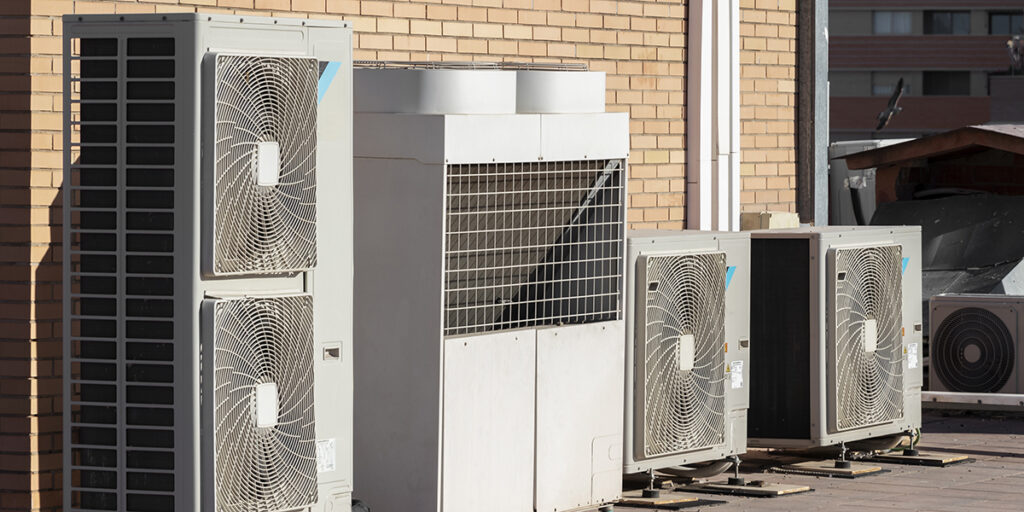Purchasing an HVAC system for your home may feel daunting if you are unfamiliar with the types of HVAC systems on the market and how they work. This HVAC buyer’s guide will provide the necessary technical information and terminology to select the best heating and cooling system for your needs and budget.
What Does HVAC Stand For?
HVAC is short for heating, ventilation, and air conditioning. The term represents a broad range of heating and cooling systems, from portable AC units and space heaters to central heating and air conditioning. To top it off, you can find multiple types of units that fall within this range.
While there are plenty of models to choose from, there are just two categories of HVAC systems: ductless or ducted. As the name suggests, ducted systems carry treated air through a sequence of ducts to heat or cool a building. Ductless HVAC systems use other means to treat and circulate air within a space.
Read on to learn more about the most common types of HVAC systems and how they work. And remember, Topline Heating and Air, your Atglen HVAC service company, is standing by to answer your questions and provide an estimate at no charge.
Ducted Heating and Cooling Systems
Residential buildings, offices, and commercial spaces routinely utilize these types of HVAC systems. There are several types of ducted HVAC systems, each with benefits and drawbacks.
Split System
HVAC split systems operate using separate components for heating and cooling, but a single thermostat manages the temperature of the entire building. The split system technology allocates the heating unit indoors, in a utility closet, basement, or storage space, and the cooling system outside.
The gas-powered heater uses a fan or evaporator to push the treated air through the ductwork. In contrast, the cooling system uses refrigerant, coils, and a compressor to generate cool air, while a fan blows hot air away from the property. Split systems are one of the most common types of HVAC systems found in apartment buildings and condominiums.
Hybrid Split System
While the split HVAC system requires gas to generate heat, the hybrid split system’s heater can burn gas or shift to electric power. While electric heating can be less potent and slower than gas, this feature allows building owners to mitigate energy consumption and reduce costs.
Packaged Cooling and Heating
These types of HVAC systems are ideal for smaller residential buildings with limited storage space. A single unit houses the heating and cooling components and fits well in an attic space, on the roof, or near the building’s foundation. Packaged heating and cooling systems are less expensive than HVAC splits and are easy to maintain.
Zoned HVAC System
The main benefit of zoned heating and cooling is the ability of the owner or occupant to manage the temperature in individual rooms or parts of a building. HVAC zoning technology works in several ways, depending on the size of the space.
One method involves installing two or more HVAC units in a home to control the climate on different floors, rooms, or parts of the house. Another option is installing dampers in the air ducts to control how much of the treated air flows into a given space. Damper systems help to direct airflow away from one zone and move it toward another. This type of zoned heating and cooling keeps residents comfortable while improving energy efficiency by shutting off zones that don’t require air treatment.
Ductless HVAC Systems
As the name suggests, ductless heating and cooling systems treat and distribute air without air ducts. These types of HVAC systems come in multiple sizes and are an ideal choice for smaller buildings, multifamily homes, apartment units, and temporary construction sites.
Duct-Free Mini-Split System
A ductless mini-split system is an electrical unit consisting of an outdoor compressor that operates in tandem with an indoor unit, refrigerant, heat pump, condenser, and a thermostat to treat outdoor air and transfer it indoors. Copper tubing connects the outdoor components with up to nine indoor units.
This duct-free system has zoning capabilities, allowing occupants to cool or heat a designated room to prevent energy loss, which compensates for the relatively high installation costs.
Hydronic Heating
Hydronic heating differs from other HVAC systems as it requires liquid to deliver radiant heat. The hydronic system heats water in a boiler and transports it into the building through pipes beneath the floors. The hot water reaches the baseboard heater or radiator, distributing heated air into the space. Homeowners can heat their flooring by installing radiant heat directly underneath it.
Portable Spot Cooler
Portable spot coolers are ideal for cooling down commercial spaces, large rooms, and outdoor spaces. These wheeled air conditioning units operate by taking in ambient air and passing it over a refrigerant-cooled coil, lowering the temperature and reducing humidity. The system then pumps the treated air back into the room. Residual condensation drains into a bucket or through a hose. Portable spot coolers are electric-powered and easy to maneuver. They can operate at any venue with an electrical power source.
Portable Heat Pump
A portable heat pump treats outdoor air by running it through a condenser coil and redispersing it through the space. Portable heat pumps operate similarly to spot coolers but have the added benefit of generating heat through a reverse valve. Portable heat pumps are an affordable and efficient heating and cooling option for small spaces with varying climates.
Contact Us
Whether you are looking for an HVAC system for a new build, an AC replacement, or a temporary climate control option for a work site, there is a heating and cooling solution to satisfy your needs.
With so many types of HVAC systems on the market today, it is comforting to know that Topline Heating and Air is just a phone call away, ready to help you choose the perfect system for your home or business.
Call us at (717) 628-6825 to arrange a consultation or keep reading to learn more about our furnace installation and repair services.

